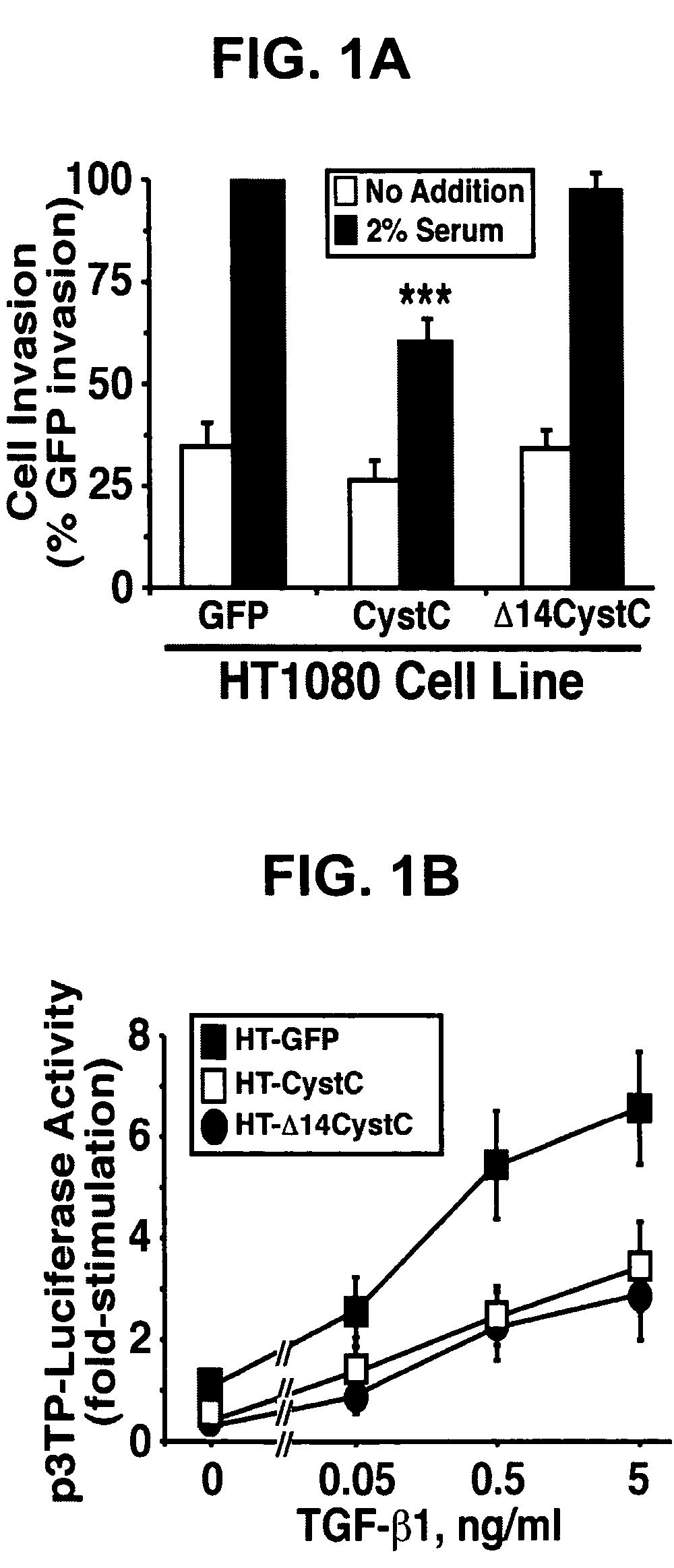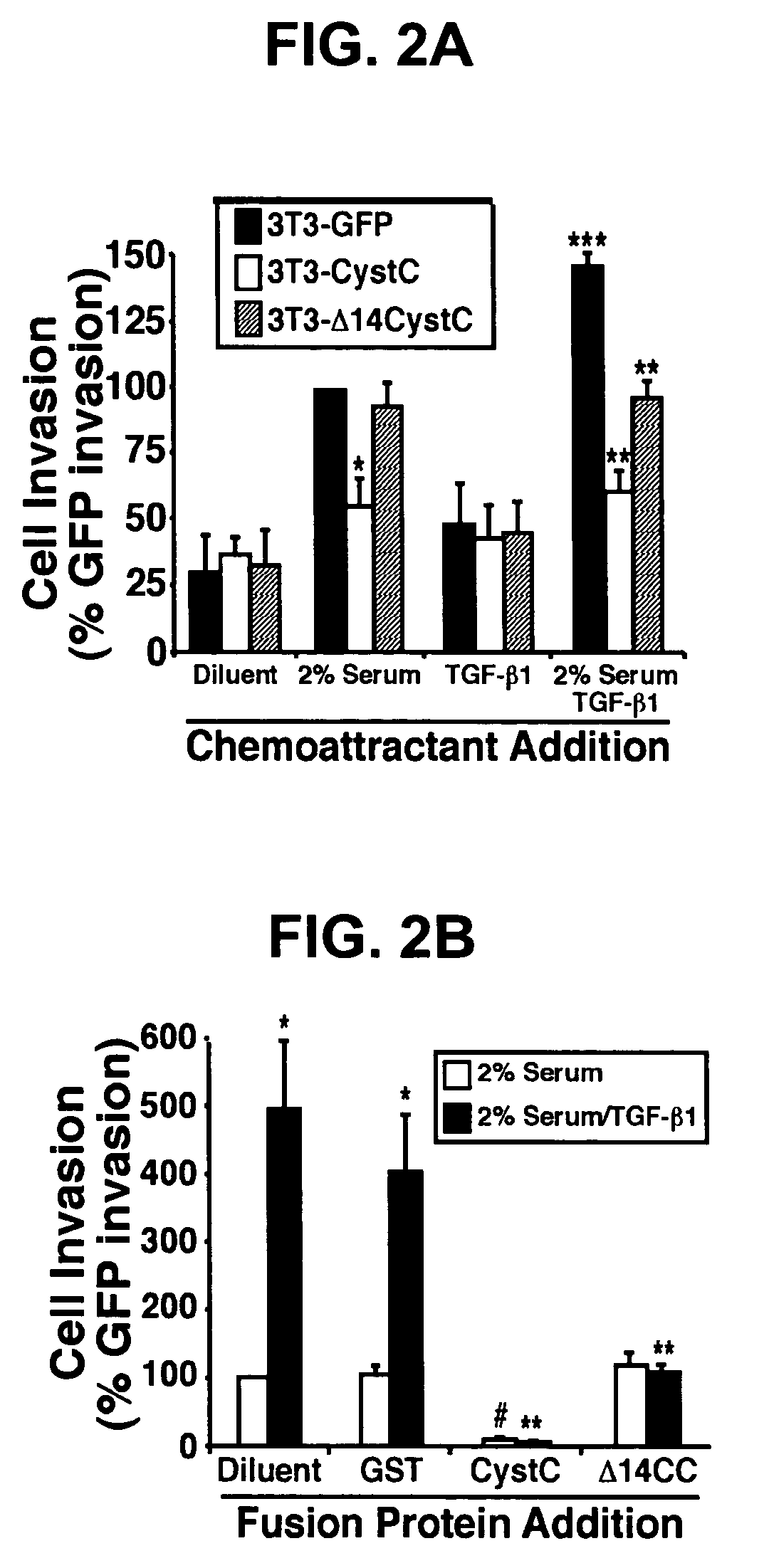Cystatin C as an antagonist of TGF-beta and methods related thereto
a technology of cystatin and beta-beta, which is applied in the field of cystatin c, can solve the problems of preventing science and medicine from developing effective treatments, the development and progression of human diseases, etc., and achieves the effects of inhibiting tumor cell malignancy, increasing expression and/or biological activity
- Summary
- Abstract
- Description
- Claims
- Application Information
AI Technical Summary
Benefits of technology
Problems solved by technology
Method used
Image
Examples
example 1
[0179]The following example demonstrates that TGF-β1 induces CystC expression in 3T3-L1 cells.
[0180]TGF-β governs cell microenvironments by regulating fibroblast expression and secretion of cytokines, growth factors, and ECM proteins that alter the survival, proliferation, and motility of normal and cancer cells. To identify fibroblast secretory proteins whose expression are regulated by TGF-β, the inventor collected, concentrated, and fractionated by 2D-electrophoresis proteins present in naive- and TGF-β-conditioned media of murine 3T3-L1 fibroblasts. Fractionated proteins were immobilized to Immobilon-P, and were visualized by Coomassie staining and autoradiography. Differentially expressed proteins regulated by TGF-β were excised and subjected to Edman sequencing. The results showed that a highly basic protein of ˜18 kDa was prominently induced by TGF-β (data not shown). Edman sequencing of this protein returned an amino acid sequence of (NH2)-ATPKQGPR-(COOH) (positions 21-28 of...
example 2
[0182]The following example shows that tumorigenesis alters CystC expression in human tissues.
[0183]Altered CystC expression has been associated with the development of human pathologies, particularly cancer (3). In order to identify human cancers potentially susceptible to altered CystC expression, a radiolabeled human CystC cDNA probe was hybridized to a membrane arrayed with matched normal / tumor cDNAs generated from cancer patients (data not shown). CystC expression was normalized to that of ubiquitin and normal:tumor tissue CystC expression rations were determined. Ratios ≧2 or ≦0.5 were considered significant. Of the 68 patients surveyed, CystC expression was altered in 65% (44 / 68) of the tumors, of which 84% (37 / 44) showed downregulation. Significantly attenuated CystC expression was especially evident in cancers of the stomach (100%; 8 / 8 cases), prostate (100%; 3 / 3 cases), uterus (71%; 5 / 7 cases), kidney (60%; 9 / 15 cases), rectum (57%; 4 / 7 cases), and colon (55%; 6 / 11 cases)....
example 3
[0184]The following example demonstrates that CystC inhibits cathepsin B-mediated invasion in HT1080 cells.
[0185]Cathepsin B is a lysosomal cysteine proteinase that functions in intracellular protein catabolism, as well as in bone resorption, hormone activation, and antigen processing (5). During tumorigenesis, cancer cells express a cathepsin B splice variant whose protein product is secreted into the extracellular milieu (5) and localized to the leading edge of invasive tumors (19), thereby promoting cancer cell invasion and metastasis. However, recent evidence has questioned the role of intracellular versus extracellular cathepsin B in promoting cancer cell invasion (20). To distinguish between these two possibilities, human HT1080 fibrosarcoma cells that stably express the murine ecotropic receptor (21) were infected with control (i.e., GFP), CystC, or Δ14CystC retrovirus. Afterward, cells that expressed GFP were isolated by flow cytometry to establish stable polyclonal populati...
PUM
| Property | Measurement | Unit |
|---|---|---|
| molecular weight | aaaaa | aaaaa |
| melting temperatures | aaaaa | aaaaa |
| temperature | aaaaa | aaaaa |
Abstract
Description
Claims
Application Information
 Login to View More
Login to View More - R&D
- Intellectual Property
- Life Sciences
- Materials
- Tech Scout
- Unparalleled Data Quality
- Higher Quality Content
- 60% Fewer Hallucinations
Browse by: Latest US Patents, China's latest patents, Technical Efficacy Thesaurus, Application Domain, Technology Topic, Popular Technical Reports.
© 2025 PatSnap. All rights reserved.Legal|Privacy policy|Modern Slavery Act Transparency Statement|Sitemap|About US| Contact US: help@patsnap.com



